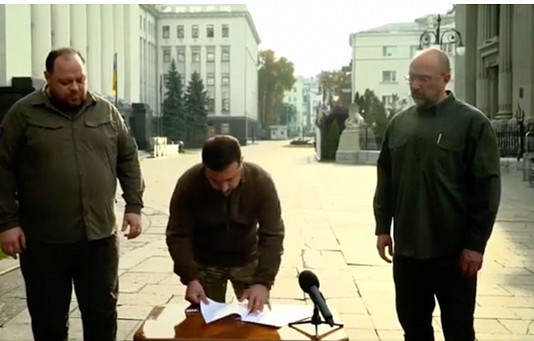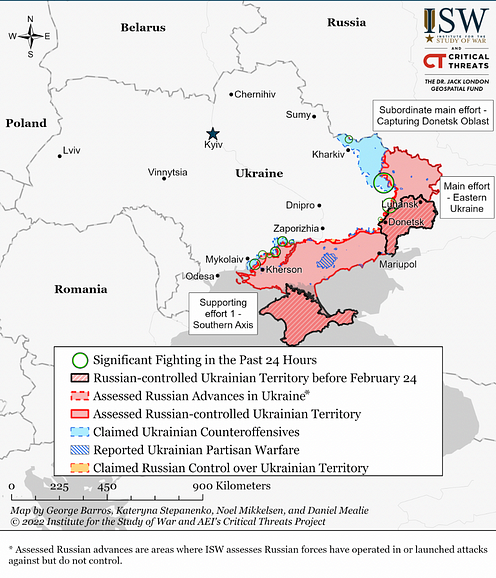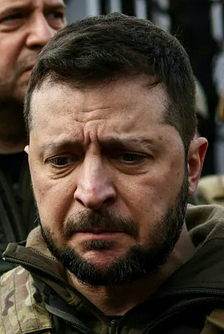October 3, 2022
On Sep. 30, Vladimir Putin strode into St. George’s Hall of the Great Kremlin Palace in Moscow through 30-foot-high gold doors opened by goose-stepping guards. He proclaimed, before hundreds of well-dressed courtiers, that 15 percent of Ukraine had been “annexed” then launched into a tirade against the past colonialism, slavery, and genocide by the West that Russia now inflicts on Ukraine. Just hours later, Ukraine’s President Volodymyr Zelensky and two colleagues, wearing military fatigues, signed Ukraine’s application to quickly join NATO at a modest table alone in a Kyiv square. But as both these ceremonies unfolded, by the perpetrator and the victim, the ongoing slaughter in the biggest war in Europe since World War II continued with no end in sight.

Strangely, there were tiny positives buried in the rhetoric. Putin claimed in his speech that he was willing to negotiate. Zelensky said he’d negotiate but never with Putin. Despite such alleged willingness, both sides escalated their war. Ukraine recaptured land inside newly-annexed territories (with tons of American and NATO weaponry and intelligence support); and Russia destroyed gas pipelines in the Baltic Sea then kidnapped the director general of the Zaporizhzhia nuclear plant on Ukrainian-controlled territory as part of its continuing nuclear blackmail.
The underscored once again the strategic dilemma here – and the impediment to negotiations at this point – which is that both parties want to optimize their gains before going to the negotiating table, wrote Major General SB Asthana, an esteemed Strategic and Security Analyst in India. “Russia’s goal remains unmet – to take over Donbas region as a whole and all of the Black Sea of Ukraine to its militarized strip of land in eastern Moldova, called Transnistria, in order to land lock and cripple the nation. Adding troops is essential to hold onto territorial gains and prolong the war through winter, to obtain leverage to get the West to reduce sanctions.”
“Ukraine’s goal is to be NATO’s champion against Russia and prolong the war in order to continue weakening its war machine” which aligns with NATO and American goals “but this may backfire eventually,” he added. The devastation of Ukraine may result in the long-term reduction of its territorial size as well as lead to an unending proxy war which may, ironically, enhance the long-term Russian threat. Besides, he said, NATO doesn’t know how it will respond if Russia drops a tactical nuclear bomb.
This weekend, The New York Times reported that Pentagon is “gaming out responses” to a tactical nuclear weapon attack, capable of killing 20,000. Most commentators don’t believe this will happen – unless Putin is backed against wall which he isn’t as yet – but the threat alone rattles the world and if undertaken would upend 77 years of nuclear non-proliferation efforts. Putin has said that an attack on his newly annexed territories would constitute an “existential” attack on Russia itself, leading to a possible nuclear response. But Ukraine ignores this “red line” and on October 1 recaptured a major city in newly “annexed territory” and continued attacking in all annexed areas. This won’t abate until there is a solution and the world edges closer toward another 1962 “Cuban Missile Crisis” moment.

Ukraine as of October 1, 2022.
Graham Allison, nuclear and crisis expert and author of the best book about the 1962 crisis, said in a recent interview in Financial Times that “nuclear powers must avert confrontations that force an adversary to choose between humiliating retreat and nuclear war. If Putin is forced to choose between losing on the one hand in Ukraine and escalating the level of destruction, there’s every reason to believe he’ll escalate the level of destruction. We know about him and his history. He had no compunction, whatever killing massively in his own city Grozny, levelling the entire city in order to quote, win, and Aleppo in Syria.”
Thus far, the White House has responded to Russia’s nuclear threats with counter-threats. President Joe Biden said such an attack would be met with “consequential”, but unspecified, retaliation. According to leaks, sources say retaliation would likely consist of massive conventional assaults that would destroy Russia’s naval fleet in the Black Sea and most Russian troop concentrations inside Ukraine. But Allison said “we have to hope to get to some resolution or some ceasefire or someplace where it stops before we give him [Putin] that option, because I think, unfortunately, there’s no reason to believe he wouldn’t conduct a nuclear strike.”
The 1962 Cuban Missile Crisis led to brinkmanship that ended, in large measure, because Washington secretly promised to remove its nuclear warheads from Turkey in return for Russia’s agreement to remove theirs from Cuba. Today, Allison said, White House and CIA officials know how to use backchannels and are likely doing so now to break through the rhetorical logjam. “I don’t know exactly what the terms would be…Putin is so much about Putin that you could do something for him or his family or somebody that he really cares about. I mean, this is like dealing with a Mafioso.”
Ironically, the current state of play may lead to a deal. The world is appalled at Russia’s war crimes. Ukraine is spectacularly successful in the battlefield. India and China are upset as are the world’s developing nations because of the damages to their economies. And, on the other hand, Russia is roiling. Many Russians are upset about Putin’s partial mobilization and hundreds of thousands head for the exits, only to be forced to remain inside Mother Russia against their will. And those who have been forced into its military are now armed and angry. Historically speaking, a cohort of armed military men is always hazardous to a potentate.
China and India will publicly speak out against the war at the October 4 Security Council meeting, providing another powerful helpful “deterrent” of sorts to prevent Putin from using weapons of mass destruction. On October 2, China’s Global Times’ editorial even bluntly called for “de-escalation and negotiation with viable options on the table to achieve an early ceasefire”.

But the only “viable options” that must be on the table are two: that Ukraine is given iron-clad security guarantees from NATO and eventual membership and that Ukraine’s lands are returned and the nation rebuilt. However, demanding Putin’s departure, no matter how desirable, is a non-starter. As Allison said “do I believe that in the end we’re going to end up having to do some version of a dirty deal with him? Most likely, and it’s gonna be extremely uncomfortable … but in World War 2 Churchill and Roosevelt didn’t have any trouble dealing with Stalin — and Stalin did kill 30, 40 million people. He [Putin] will remain a pariah the way Kim Jong Un is. But we’re gonna have to live with him.”
Diane Francis Newsletter on America and the World
30-day free trial at https://dianefrancis.substack.com/about
The views expressed in this article are the author’s and not necessarily those of the Kyiv Post.
